Orchid leaves turning yellow is a sign the plant needs help, and the usual problems that turn orchid leaves yellow are generally easy to fix.
The most common reason for orchid leaves turning yellow is excessive watering. The plant’s leaves turn yellow because of root rot, which kills the roots and prevents the plant from receiving enough water and nutrients. Watering less, cutting off the dead roots, and replanting the orchid are the best ways to solve the overwatering problem.
9 Causes of Orchid Leaves Turning Yellow (& How to Fix)
Orchid leaves are a vibrant green color. The leaves wilt and turn yellow when the plant is distressed. Since many causes can turn the leaves yellow, diagnosing and solving the problem isn’t always easy.
Here are the common causes of orchid leaves turning yellow, along with how critical each problem is to the plant’s health. Also included are the best methods to prevent the leaves from turning yellow, and detailed instructions on how to fix the problem if the leaves have already started to wilt and turn yellow.
Over-Watering Can Cause Orchids to Turn Yellow
Adding too much water to the orchid’s pot is the most likely reason for the orchid leaves turning yellow. The natural living conditions create plenty of aeration for the orchid. The plants grow outwards from trees and use their leaves to catch water droplets from humid atmospheric conditions.
Too much water left sitting in an orchid’s pot prevents adequate aeration of the plant, leads to root rot, and causes the leaves to turn yellow and possibly die due to insufficient nutrients.
Continual overwatering leads to the plant’s eventual death, but improving the watering routine rejuvenates the plant.
Follow these steps to prevent or correct overwatering of an orchid:
- Check for root rot. When you notice the orchid’s leaves turning yellow, look for blackened, limp roots
- Cut off or trim any blackened roots before repotting the orchid
- Replant the orchid in a fresh, loose potting medium made of pine bark chippings, and don’t use ordinary potting soil and moss. Use a pot with enough holes for adequate water drainage to prevent excess water from sitting in the soil for too long
- Mist the leaves when they’re dry. Avoid watering the plant in the first week
- Water the orchid once every 7 to 14 days after the first week. Let water stream through the pot for 15 seconds before draining the water. Check that the soil is dry before watering an orchid. The top inch of soil should dry out, and the visible roots should be light gray before watering is necessary
Under-Watering Can Cause Leaf Yellowing
Orchids are hardy plants but they suffer from underwatering and low ambient humidity.
Dehydrated orchids show a softened main stem, and limp, shriveled, yellow leaves. The dehydrated orchid’s roots may appear dry, white, and wrinkled because of too little water. A lack of water prevents the orchid from soaking up nutrients.
Underwatering the plant leads to the death of the orchid, but an underwatered plant can be saved if the problem is noticed early. While saving the plant, the plant may lose its leaves, but the leaves should grow back.
To correct the underwatering problem, submerge the plant’s root ball in a water-filled basin and leave the plant to soak for 10 minutes before returning the orchid to its original soil, then follow these tips:
- Water the orchid when the top inch of soil is dry, or about once per week during summer and spring, and once every 14 days during winter and fall, by soaking the plant or streaming water through the pot
- Mist the plant’s leaves, roots, and stem every other day
- Keep ambient humidity between 40% and 70% and keep the orchid away from drafts
- Keep the plant away from harsh sunlight. Orchids generally need bright indirect sunlight, and too much light further dehydrates the recovering plant
Natural Aging Process Causes Leaves to Turn Yellow
Yellowing leaves on an orchid can signify the plant’s natural aging process. When only the leaves at the base of the plant turn yellow, the cause is typically aging.
An orchid reduces water flow to the lower leaves when it’s time to grow new vibrant green leaves. Yellowing leaves caused by natural aging shouldn’t be a cause for concern.
Aid the plant during its aging process by doing the following:
- Don’t cut off the yellow leaves because this can damage the plant. Let each yellow leaf drop off naturally
- Monitor the new leaf growth by ensuring fresh, vibrant leaves are growing in the place of the older leaves. If there isn’t new leaf growth, this means the plant has a problem
- Keep watering the plant correctly and give it orchid-specific fertilizer
Yellowing Leaf Caused by Too Much Direct Sunlight
Orchids, especially Phalaenopsis orchid, grow under canopies in lush forests, where the plants receive indirect sunlight. When a house orchid is placed in too much direct sunlight, the leaves turn yellow and develop burn marks or cracks.
Direct sunlight bleaches the vibrant green leaves, turning the leaves yellow or light gray patches. Leaves that don’t receive direct sunlight aren’t affected.
Too much direct sunlight dehydrates, burns, and causes severe damage to orchid leaves. The leaves typically don’t heal from burns, but the plant can be revived if treated correctly. The length of the healing process depends on how many leaves were affected.
- Move the plant to a spot that receives bright, indirect sunlight every day. For example, choose a spot in a window without direct sunlight or behind a transparent curtain that dampens the sun’s rays. Too little light causes the leaves to turn yellow, limp, and pale
- Re-pot the plant in a plastic container to allow the indirect sunlight to reach the roots. The plant’s roots encourage photosynthesis when the burnt leaves can’t
- Wait for the burnt leaves to fall off naturally, instead of cutting them, to prevent further harm to the plant
Fungal or Bacterial Infections Cause the Leaves to Turn Yellow
Infections affect orchids and are caused by various conditions, including extreme temperatures and humidity levels.
Overwatering is another cause of infections in orchids. When a fungal infection attacks the plant, fungal spores and black fungal leaf spots appear along the plant’s leaves. Bacterial infections cause limp, yellowing leaves.
Fungal or bacterial infections first appear as yellowing areas at the bottom of the leaf and can have a foul smell if of a bacterial origin. Severe infections turn the plant’s leaves black and cause stem and root rot.
Plant infections are dangerous to the plant and need early treatment.
- Move the plant away from other house plants to avoid spreading the disease
- Let the plant dry out before watering it again if the infection is caused by over-watering
- Cut off the infected areas of the plant using sterile scissors. Take care not to touch the healthy leaves
- Remove any blackened and soggy roots if the problem is caused by overwatering
- Use fungicides for a fungal infection or bactericide sprays for bacterial infections on the healthy areas of the plant
Nutrient Deficiencies Can Lead to Orchid Leaves Turning Yellow
Orchids, like moth orchids, need the right amount of nutrients to remain healthy. These species need few, high-quality nutrients. When the plant lacks the proper nutrients, the orchid leaves turn yellow and limp.
The most common nutrient deficiencies in orchids are nitrogen, zinc, phosphorus, calcium, copper, and manganese, which generally cause an iron deficiency. The lack of iron in the plant causes leaf yellowing.
Too much fertilizer has the same effect on the plant as too few nutrients. Common houseplant potting soil doesn’t contain the correct amount of nutrients for orchids, causes the leaves to turn floppy, and prevents flowering.
Follow these steps to fix the fertilizer problem:
- Rinse the plant thoroughly under running water to remove the excess or low-quality fertilizer
- Wait a week or two before adding more fertilizer if the problem was too-much fertilizer
- Add fertilizer to the plant regularly during the summer. Don’t fertilize during winter, fall, or while the plant is flowering. Use premium orchid fertilizer on the plant according to the package’s instructions
Environmental Changes Lead to Yellowing Leaves
Orchids are highly sensitive to environmental changes — both small (moving the plant to a different room) and drastic changes (taking the plant home from the store or seasonal changes).
Orchids eventually adapt to the new environment.
- Pick an ideal spot for the orchid where the humidity is 40% to 70%, and the plant receives indirect sunlight
- Water and fertilize the orchid correctly to keep the plant healthy
- Move the plant around during the seasons to ensure the plant has proper ambient humidity levels and gets enough indirect light — but not too much sunlight
- Track the various environmental changes to determine what causes the plant the most stress
- Make environmental changes gradually to help the plant transition
Yellowing Leaf Caused by Potting Stress
Repotting an orchid can lead to transplant shock, especially if the plant lives in poor conditions. Once the plant is repotted, the orchid’s leaves turning yellow is a sign that the plant isn’t handling the environmental change well or the new potting medium is incorrect.
The severity of potting stress depends on how many changes the plant experiences, the length of time it spends in incorrect conditions, and how often the plant is repotted.
Follow these steps to prevent and cure repotting stress:
- Re-pot an orchid every two to three years or when the roots turn white — not due to under-watering — and the plant is cramped in its pot. Avoid repotting orchid plants more than necessary
- Use free-draining and porous potting media in the new pot
- Place the newly potted plant in a spot with ideal temperature, humidity, and lighting requirements
- Provide the plant with the correct amount of water and orchid fertilizer to help the plant adjust to its new pot
Pest Problems Make Orchid Leaves Yellow
The moth orchid often attracts unwanted pests that invade the plant, reproduce, and cause yellowing leaves, discolored spots, and webbing. Common insects found on orchids, such as scale insects, mealybugs, and spider mites, are only visible through a magnifying glass or by carefully inspecting underneath the plant’s leaves.
- Move the orchid away from other plants to prevent cross-infection
- Wash the insects off the plant using a solid water flow over the yellow leaves
- Use a damp cloth to wipe the insects off the yellow leaves
- Replace the potting mix to rid the soil of any insects
- Use an orchid-friendly insecticide on severe infections
How to Find the Reason for Yellowing Orchid Leaves
Take action at the first sign of a yellow leaf on an orchid to prevent severe problems that kill the plant. When you notice a piece of a leaf or an entire leaf turn yellow, look at the roots for the cause of the color change first and correct the issue slowly.
Examine for Root Rot
Remove the orchid from the pot and examine the orchid roots to determine whether there is evidence of root rot. Healthy orchid roots are green and firm, while problematic orchid roots turn gray, white, or black.
Color changes in the root system indicate that the problem is due to over- or under-watering. Healthy roots mean the yellow leaves are caused by environmental problems such as humidity, temperature, or nutrient issues.
Adjust Watering
Add more water if the roots are gray or white and replace the potting soil or lengthen periods of no water if the roots are black — a common sign of root rot.
Create a Recovery Area
Keep the orchid in a place with proper humidity and sunlight conditions while it heals. Follow orchid watering recommendations.
How to Prevent Yellow Orchid Plant Leaves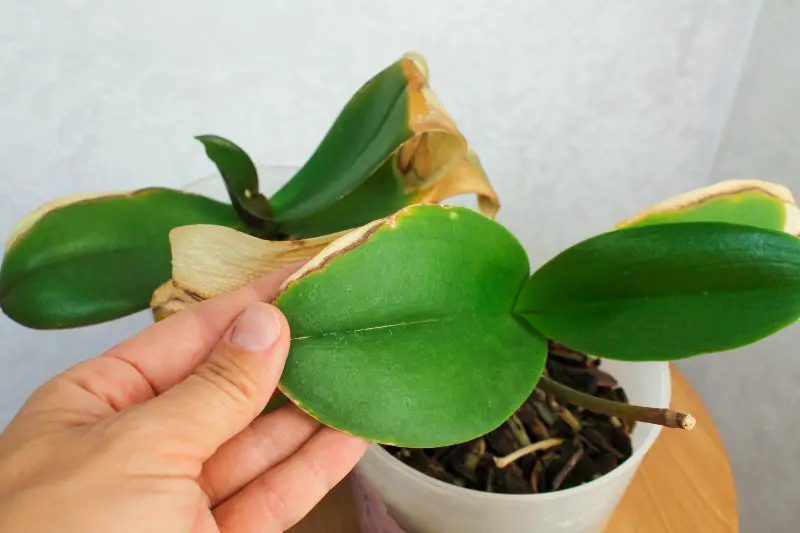
Prevent yellowing leaves on an orchid by providing the plant with the proper lighting, water, humidity, and fertilizer requirements. Orchids are easy to grow and care for but may still develop yellow leaves if the proper care requirements aren’t met.
Look for yellow leaves caused by the stress of introducing the new plant to your home. Immediately provide an ideal environment for the plant to help it recover.
Place the orchid in bright, indirect sunlight. Water the plant every 7 to 14 days or when the top inch of soil dries out and the visible roots turn light gray. Keep the orchid in a well-ventilated pot with adequate drainage to prevent root rot caused by stagnant water.
Maintain an ambient temperature of between 55 to 75°F and humidity between 40% and 70%. Keep the plant away from draughts to avoid drying out the plant. Fertilize the orchid using high-quality fertilizer developed for orchids and keep the plant in the correct potting medium — pine bark shaving for orchids.
Key Takeaways
Yellowing leaves on an orchid are commonly a sign of overwatering or the plant’s natural aging process. Yellow leaves are often a sign that something is wrong, and the problem can usually be resolved.
Find the cause of the yellow leaves before making any changes to the plant. Maintain the correct potting medium and ambient temperature and humidity requirements to keep an orchid healthy and the leaves vibrant green.
FAQs About Orchid Leaves Turning Yellow
Here are the answers to common questions about orchid leaves turning yellow:
Should I Remove Yellow Leaves From Orchids?
No, you shouldn’t remove yellow leaves from orchids because cutting off leaves can cause more damage to the plant. Open cuts on the plant allow fungus and bacteria to enter the plant, causing infections.
When Should I Remove Orchid Leaves?
Remove orchid leaves when there are signs of a bacterial or fungal infection. Black and brown spots on the leaf, a bad smell, root rot, and limp, yellowing leaves are signs of disease. Cut off the black and yellow leaves using sterile scissors.
Will Yellow Orchid Leaves Turn Green Again?
No, the orchid’s yellow leaves won’t turn green again and will usually die and fall off the plant. However, new green leaves grow once the plant has recovered from the disease or problematic environmental conditions.
When Should I Re-Pot an Orchid?
You should re-pot an orchid once every two to three years or when the plant is severely cramped in the current pot and the roots turn white despite receiving enough water. Add the same high-quality potting medium used in the original pot to the new pot to ensure a stress-free transition.

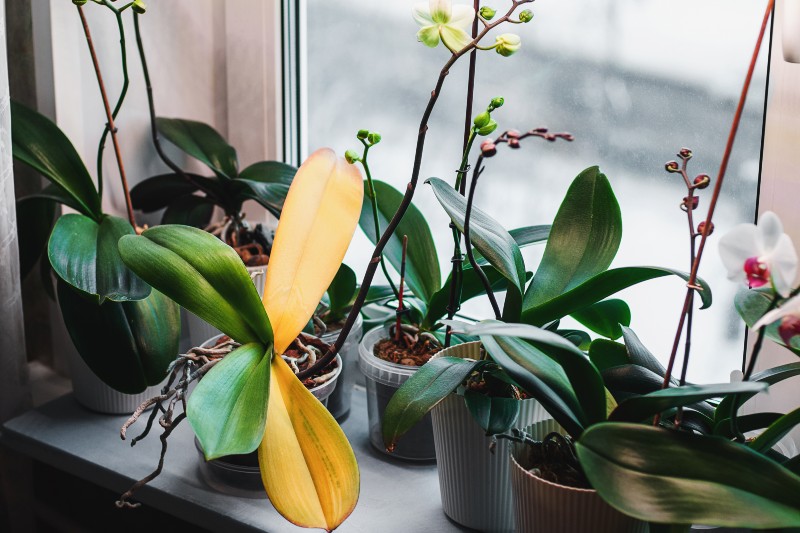
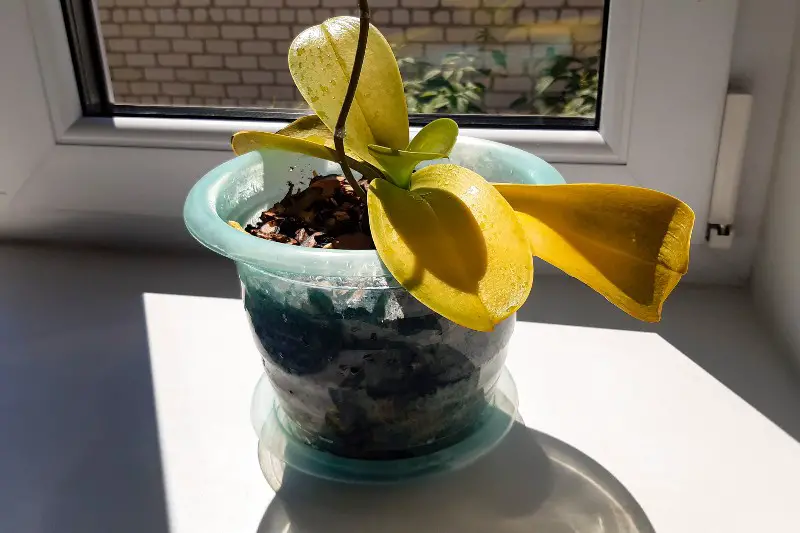
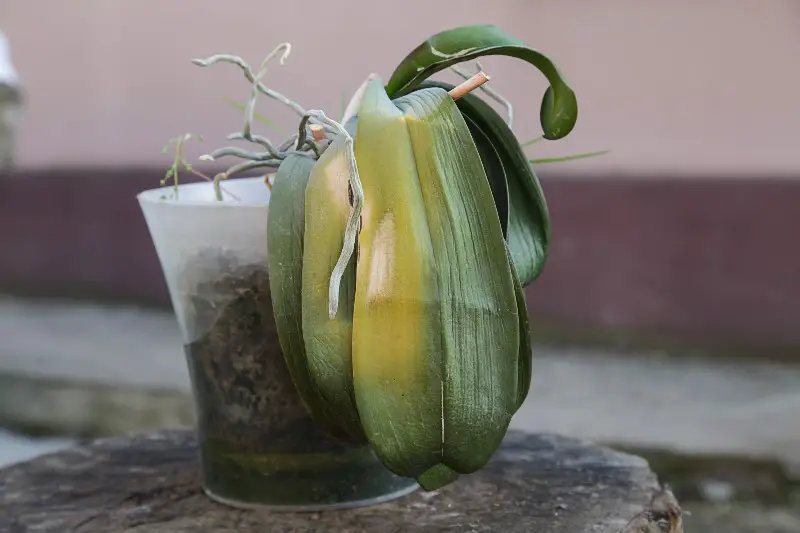





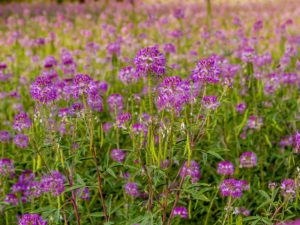
Amazing information, if you need any information on how to grow plants an vegetables healthier and stronger with the help of botanical bio- pesticide, do check us out at Green Era Agri Innovations.